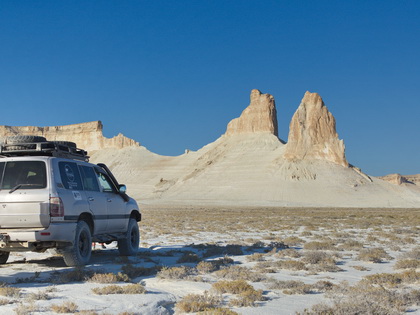Astana History, part 2

In December 1960 the city had 100,000 people when it became the center of the Tselinny territory of north Kazakhstan. Shortly after in 1961 Akmolinsk became Tselinograd. In 1971, the Tselinny territory was abolished and Tselinograd became the center of the region. In 1992 the city took its former name - Akmola - again. There are several versions of the origin of this name. The first one is that the area of Akmola was named after the white-coloured lime-stone hill.
According to the Byzantine writer Prokopius the Huns called mola a high barrow or fortress. Akmola was a major center for cattle fairs and famous for the abundance and variety of its milk products (koumyss, shubat, etc.). Hence its name, literally 'ak mol' - white abundance.
Akmola translates into 'white holy place'. This is actually the final choice of the members of the Republican onomastic committee after a meticulous study of all available historical sources.
The Akmola region lies in the North of the central part of Kazakhstan with a territory of 96,800 sq km. Its relief is far from uniform and includes hillock areas and low mountains, plains and river valleys. In the North we find spurs of the Kokshetau elevations, in the South and South-East Saryarka (Kazakh hummock topography) and plains in the North-East.
The climate is a harsh continental one becoming arid to the South. The average temperature ranges from -14/18° C in January to +20/24°C in July. In winter it can be as cold as -40°C whereas summers are quite hot (sometimes above +35°C) with dust storms and dry hot winds. Summer lasts 194-202 days, winter 163-171 days and there are about 105-130 days above freezing. The annual precipitation is 200-300 mm.
The largest rivers are the Ishim and the Nura Rivers. Lakes include Tengh, Karasor, Korgalzhyn, Balyktykol and Kypshak. There are 55 species of animals, 180 species of birds and 30 species of fish. Rare species (listed in the Red Book) include the Pamir argali (arkhars), Saker falcons, golden eagles, bustards, Demoiselle cranes, steppe eagles, Dalmatian pelicans, little bustards and flamingo. Korgalzhyn state preserve and a number of game reserves were set up to protect these endangered species. There are 66 plant species over 4,391.6 ha. According to the 1999 census the Akmola population is 836,200 (319.000 in Akmola city) with a density of 7.5 per sq km.
Akmola has several universities including the L.Gumilyov Eurasian University and the A.Barayev Research Institute of Grain Farming reputed throughout the international scientific community. There are also three museums, two drama theatres and branches of the Union of Writers and Artists of Kazakhstan publishing over 40 newspapers and 2 literary magazines.
Akmola region is by right one of the Republic's granaries and a main center for agricultural machine-building. In fact it produces one fifth of all grain (one fourth being sold to the state) and one tenth of all cattle-breeding products. Crops account for 3,423 ha. Meat and milk cattle-breeding, pig-breeding, sheep-breeding, horse-breeding and poultry farming are also well developed. The region has deposits of gold, uranium, bauxite, antimony, copper, lignite, caoline ores, quartz sands and other commercial minerals. Agriculture and processing of agricultural products are the traditional regional industries. The region encourages foreign investment and maintains mutually-advantageous relations with neighbouring and other countries. Russia, Uzbekistan, Belarus and Tajikistan are major trade partners. The main exports to CIS countries are grain, meat, flour and milk products while imports consist in fuel and power resources, chemicals, timber, saw-timber, paper, rolled stock of ferrous metals and consumer goods. Most other trade partners are the USA, China, France, Germany, Turkey and Austria. These countries receive uranium oxide, molybdenum and fertilizers and provide food products and agroindustrial machinery.
Astana History 1 - 2 - 3


